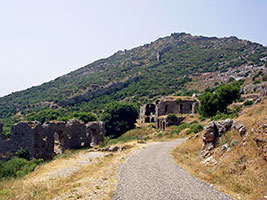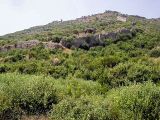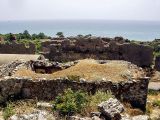At about 6 km southwest of Anamur, on the southernmost tip of Asia Minor, slumber the ruins of the ancient settlement of Anemurium (also spelt Anamurium or Anamuryum), or Anemurion in Greek. Anemurion actually means windy cape, from "anemos", meaning "wind" in Greek. The city was founded by the Phoenicians in the 12th or 13th century BC and was later occupied by the Assyrians and Hittites. Anemurium flourished during the Roman period and became a great trading centre. Anamurium was at its peak during the 3rd century CE and most remains date from that period. In the 7th century CE, Arab corsairs raided and pillaged the coast, and Anamurium was abandoned and left alone as a Byzantine ghost town. Recent excavations have unearthed evidence suggesting that the city was destroyed by an earthquake in the 6th century CE.
Approaching the ancient Anemurium, one is first confronted with the ruins of the city walls. The city walls encircling Anamurium are 1,700 m long and 500 m wide and are supported with watchtowers. Construction of the walls was from 4th century BC - 4th century CE. Next, there is the odeon, which dates from the 2nd century CE, has 900 seats and was used as a music hall and meeting hall. The public baths date from the 3rd century CE. Two aqueducts running north to south supplied potable water to Anemurium's citizens and served also the city's fountains and baths. The necropolis contains numerous freestanding tombs, but the most notable are close to the public. Towards the beach, there are the remains of a bath complex and a palaestra, i.e. a training and parade ground. This training school for all kinds of physical exercises, together with the complex of the public baths, covered an area of 1000 square meters.
https://www.turkeyphotoguide.com/anamur-anemurium?tmpl=component&print=1#sigProIdfbc7aa0856





















